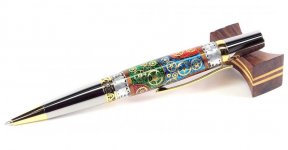Hi Margo
There are lots of opinions on this so you'll probably get quite a few answers but the main principle is the same, which is progressing through finer and finer abrasives until you get to the point where the scratches are so fine that the naked eye can no longer identify them and it looks nice and shiny.
It starts with getting the best finish you possibly can off the tool. The process I then apply leads to using a buffing wheel but as you don't have one I won't confuse you with what I do and instead encourage you to have a look at the advice Phil gave on using burnishing cream in your previous post. If you follow those instructions you'll get a fantastic finish.
(I do effectively the same thing but in my case I hold the stationary pen against a spinning buffing wheel which has polishing compound rubbed into it. The approach Phil is suggesting is where the pen is spinning and you hold the polishing liquid against it via a paper towel).
And you don't need CA when finishing resins/acrylics. CA is used frequently to finish wooden pens and hybrids as it helps to seal and stabilise the wood (especially if it is a bit punky) and also gives you a thin coating of "plastic" over the wood that you can then polish to a shine. In effect it turns the wood into something you can finish in the same way as you would with resin, if that makes sense. (However you don't really need CA to finish wood either, as there are other options that are documented on this forum).
Hope this helps.
Cheers
Ash



